Stay updated with the latest - Click here to follow us on Instagram
‘Those who demand their rights, are they traitors?’: Voices from Jamia CAB protests
“You can’t treat us like this,” a student angrily retorted after a group of policemen and policewomen start beating them with lathis.
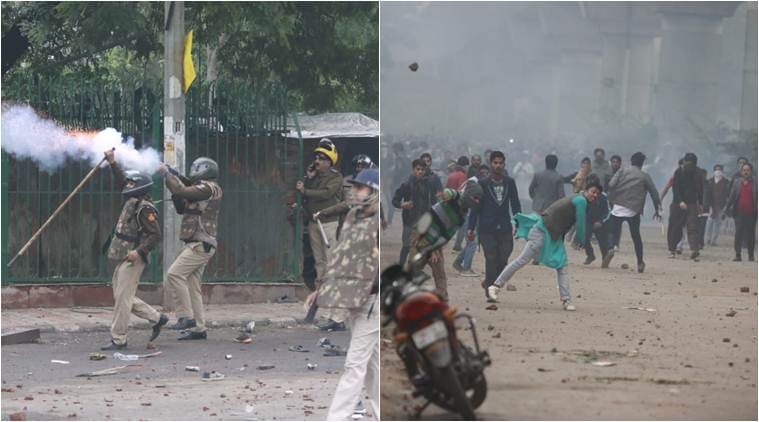 At least 42 students were detained and over 25 injured Friday after Delhi Police fired tear gas shells and resorted to lathi charge during a protest against the new citizenship law at Jamia Millia Islamia.
At least 42 students were detained and over 25 injured Friday after Delhi Police fired tear gas shells and resorted to lathi charge during a protest against the new citizenship law at Jamia Millia Islamia.
On a stretch of road, on the edge of Jamia Millia Islamia University in the national capital, the line between law and lawlessness blurs. A row of yellow barricades is the newly-drawn battle line, where police and students, soaked in the early winter rain, hurl bricks at each other.
As the chorus against the new Citizenship Amendment Act grows louder and students’ march swells ahead, tear gas shells are fired by the police. The wave of protest retreats beyond the next barricade and the police march ahead till another wave of students emerges from the smogged roads, forcing them to fall back amid raining bricks and stones. A vehicle-mounted with a water canon is called in along with additional reinforcement.
On a cold December evening, the barricaded campus of one of India’s most prestigious universities is transformed into a ghetto of protesting students — young men and women in their early 20s carrying their backpacks and water bottles, like they usually do in college.
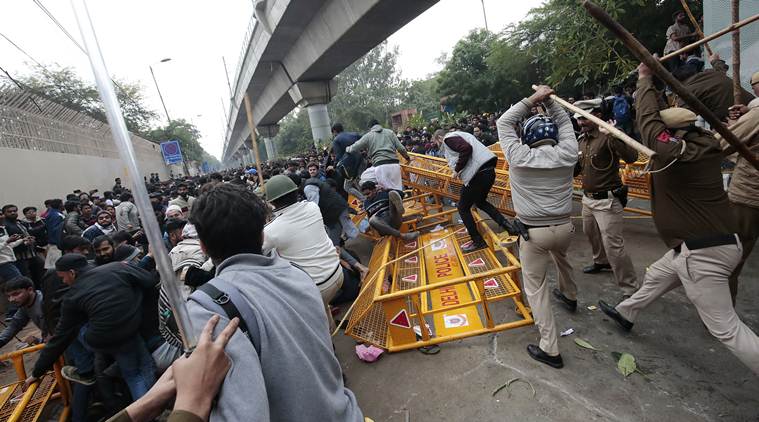 At a protest against the new citizenship law outside the Jamia Millia Islamia university in New Delhi on Friday. Praveen Khanna
At a protest against the new citizenship law outside the Jamia Millia Islamia university in New Delhi on Friday. Praveen Khanna
“Scrap CAB,” shouts a young girl, with her head covered in a scarf, as she and a group of students manage to breach the barricade to enter the “police territory”. “You can’t treat us like this,” she angrily retorted after a group of policemen and policewomen start beating them with lathis.
Some journalists, locals and police officers intervene and the charging policemen retreat.
“There was a call to march to Parliament against the new Citizenship Bill and NRC from our campus, but even before the march could begin, police lathicharged on the students. Many students were rounded up and taken away just at the beginning of the protest march,” says a first-year journalism student, who had also breached the police barricade.
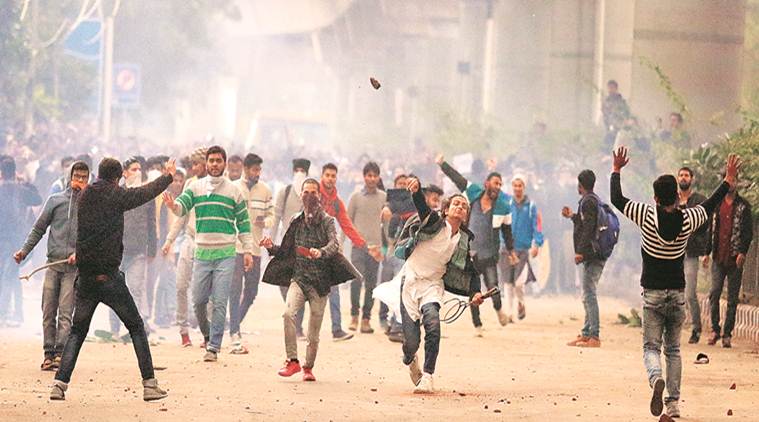 Both sides accused the other of excesses. Protesters claimed they were only retaliating against police violence. (Express photo by Praveen Khanna)
Both sides accused the other of excesses. Protesters claimed they were only retaliating against police violence. (Express photo by Praveen Khanna)
As another protester is beaten up by lathi-wielding cops on the footpath, a group of journalists and students try to capture the video on their cellphones. But a police officer tries to snatch their phones. The cop, whose uniform doesn’t carry the name badge, disappears into the crowd of standing policemen deployed on the “battle line” after he is confronted by students and journalists.
Notably, many policemen were not seen wearing their name badges.
In the meantime, a group of protesting students resurfaces on the opposite side of the road, named after the Khilafat movement leader, Maulana Mohd Ali Johar. With torn posters of “No CAB, No NRC”, they chant slogans against Prime Minister Narendra Modi and Home Minister Amit Shah.
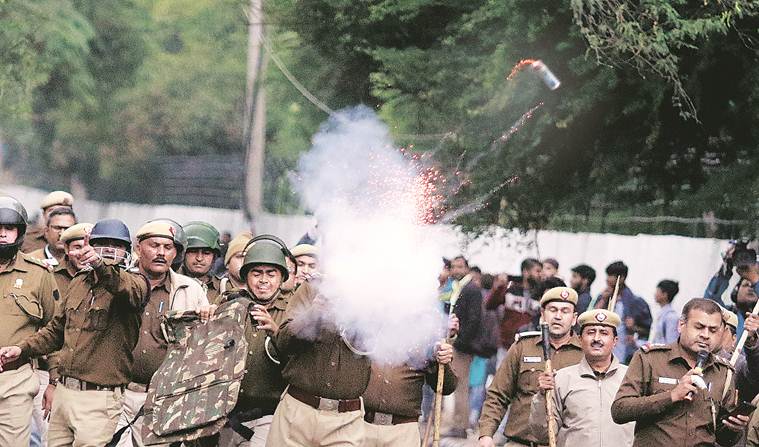 Police claimed they used lathi charge and teargas to disperse protesters who had started pelting stones. (Express photo by Praveen Khanna)
Police claimed they used lathi charge and teargas to disperse protesters who had started pelting stones. (Express photo by Praveen Khanna)
“Haq jise chahiye, wo kya desh ka gaddar hai? Aap kaise chup karayengey hume? (Those who demand their rights, are they traitors? How will you stop us from speaking out?),” says a student.
As a handful of policemen charge towards them, a young student refuses to retreat and shouts back in English, “You have destroyed our country’s democracy and Constitution.” As he stays put on the road, voicing his “khilafat”, policemen also stop.
A group of students then approach the policemen and asks cheekily, “Upar se kya order aaya hai aapko? (What orders have you got from the top?).” The policemen then tell them to “just stand behind the line”.
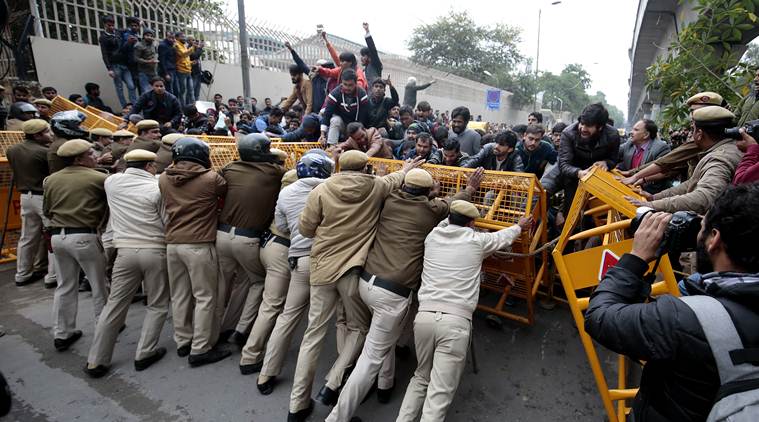 At a protest against the new citizenship law outside the Jamia Millia Islamia university in New Delhi on Friday. Praveen Khanna
At a protest against the new citizenship law outside the Jamia Millia Islamia university in New Delhi on Friday. Praveen Khanna
Amid slogans directed at the Delhi Police – “Apni Baari Yaad Karo, Tis Hazari Yaad Karo (You too remember Tis Hazari)”, a JNU student, who had come to take part in the protest, says, “Some students’ outfits had given a call for today’s protest march to Parliament. But there are no leaders… It’s a leaderless protest. The students should not have pelted stones at the police. They should have shown restraint. But yes the police should have lathicharged too.”
The slogan was referring to the incident of lawyers beating up policemen at Delhi’s Tis Hazari court last month.
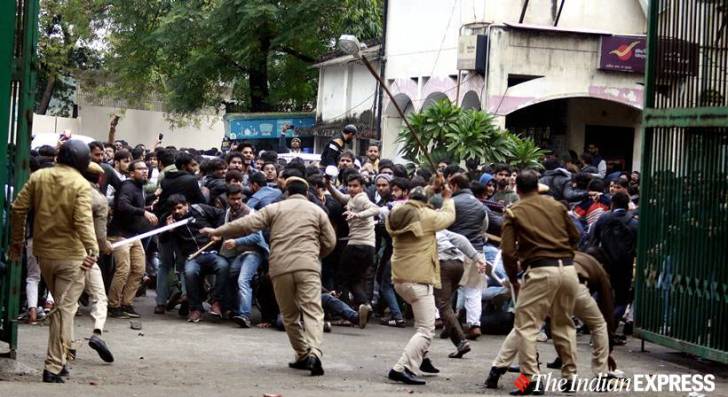
As evening sets in, a group of protesting Muslim students offer prayers on the footpath. Not far from them, beneath the Metro Pillar No 44, a group of students – three girls and two boys – sit with their backpacks and talk about the protests in Shillong – their conversation occasionally disrupted by the sounds and flare of firing teargas shells nearby.







